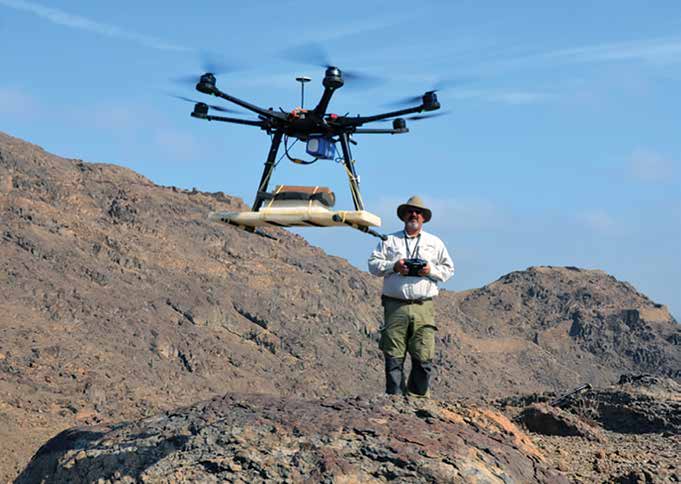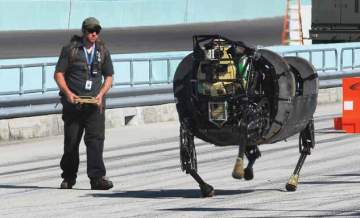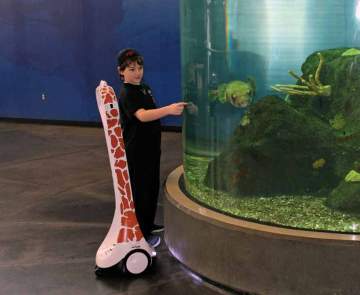
For decades (if not centuries), futurists, writers and inventors have promised that robotic help—mechanized beings ready to serve as soldiers, maids, chauffeurs—is just on the horizon. In 1988 pundits predicted “convenience robots” would be part of our everyday life by the year 2000. But that horizon keeps receding. So far, more time has been spent angsting over whether robots will take over the world than actually making use of them. But advances in the last five years may signal that the age of the robot has at last arrived, and we may be on the brink of a “Cambrian explosion” in robotic evolution. Really. This time we mean it.
We’ve had effective industrial robots for some time—strong, fast, accurate, tethered to one spot, and walled off from the co-workers they could potentially maim. This century is seeing the rapid development of smaller, mobile robots with a far wider range of capabilities. Now robots are gentle enough to help nursing home patients into or out of bed, and can come equipped with electronic “skin” responsive to the lightest touch. At the more muscular end of the scale, the Department of Defense’s DARPA Robotics Challenge is spurring the development of robot strength, dexterity, mobility, and “supervised autonomy” in decision making, resulting, for example, in headless robotic pack mules (more formally known as the “Legged Squad Support System”) that can carry 400 pounds over rugged terrain. They have also demoed the first gun-toting robots, either controlled by a remote operator or programmed to fire on their own.
Undersea, amphibious snake robots can explore the depths of the ocean, while autonomous robot jellyfish conduct military surveillance. Researchers are creating cyborg roaches and miniature flying robots to explore collapsed buildings looking for survivors. Medical technologists are enlisting robots as surgical assistants and to enable doctors to practice poking around in virtual brains before they tackle real ones. The first robots to become truly ubiquitous may be self-driving cars—legal in three states and the District of Columbia, and projected to transform the automotive industry, urban design and our transportation grid.
Robots are becoming more human: walking (even on unstable surfaces like sand), dancing (including Gangnam style, of course), sitting, walking and using facial expressions. It is, after all, functional for robots to be humanoid in a world created for humans to navigate. And people may not be comfortable interacting with robots until they are a bit more like us. Zoe, a digital visage, has the ability to express human emotions on demand—which could help create computers (and robots) that people can actually converse with. Perhaps surprisingly, one emerging role for robots is serving as companions—providing a supplement to or substitute for human interaction. Projo is programmed to be the “ideal peer learner” for students, helping them self-correct their work. Robots can be particularly good at working with autistic children, who “understand the physical world much better than the social world.” The year 2013 saw the launch of the first robot into space. Kiribo was sent to provide companionship for astronauts on the International Space Station, but his creators at the University of Tokyo are interested in droids’ potential to provide company for anyone living alone, especially the elderly.
One important cybernetic subspecies is the telepresence robot: a physical stand-in that an individual can control remotely, using the ‘bot’s mobility as well as its (two-way) video and audio feeds. Telemedicine robots enable doctors to “beam in” to remote clinics or to hospitals lacking staff with expertise in a particular area. Teleteachers may improve education by letting “the right people be in more places at once.” These robots also provide a way to mainstream people formerly relegated to the sidelines. Children with compromised immune systems can attend school via proxy robots. Quadriplegics can control telepresence robots (or fly drones!) via eye movements.

obey voice commands.
Finally, we are seeing the development of true cyborgs, as humans incorporate ever more sophisticated robotic components onto and into their own bodies. A new generation of prosthetic limbs can be controlled by nerve signals sent by the brain. Technology has already been developed and tested that lets paralyzed patients control robots via their brainwaves. Robotic exoskeletons can provide an assist to weak muscles or enable people who are paralyzed to walk on their own.
What This Means for Society
In 1942 Isaac Asimov introduced the Three Laws of Robotics, tackling the issue of how we would include ethics in robotic programming. The ethical implications of robots have become more urgent in the past couple of years, as the military deploys pilotless drones that can both make decisions and act on them. Asimov’s laws are not questions for the future anymore, they are questions for now. Robots also raise the reciprocal question of our ethical responsibilities to these increasingly life-like beings. Can robots be abused? Should they have rights?
Whatever the programming we provide to guide robots’ behavior, we also have to grapple with our own. How will we choose to deploy robots, even if we retain control over their actions? The Stop the Killer Robots campaign seeks appropriate boundaries on what we authorize robots to do on our behalf, and roboticists are confabbing with ethicists on the constructive and destructive potential of their work. The UN’s Convention on Conventional Weapons has added “killer robots” to its agenda for 2016, at which point they may be banned. And if not, could the 21st century see our first largely robotic war?
At times we have looked forward to our new robotic helpmeets, but quite often “technodystopians” angst over whether robots will take over not only manufacturing but also white collar jobs like teaching. People tally the professions—pharmacist, paralegal, taxidriver—that may be lost, if not to robot overlords then to robot scabs. (Though it has been noted that robots may help finally create gender equity in jobs and wages, as they are less likely to take over jobs based on social skills, which women tend to dominate.) Certainly between the sophisticated artificial intelligence of IBM’s Watson (an intelligence not housed in a robot, at least not yet), and the increasing physical and perceptual abilities of robots, there will at least be a shift from some jobs that required manual dexterity or data analysis to jobs requiring the skills to invent, build, program and maintain these machines. But we may well find that, as with the big data analytics explored in an earlier essay in this report, the real question is not whether robots will replace people, but how they will supplement their work.
The merging of human and machine amplifies questions already raised by doping scandals and quarrels over the extent of any given athlete’s ability or disability. Double amputee Oscar Pistorius qualified for the (mainstream) London Olympics in 2012, fueling arguments about whether his high tech but purely mechanical prosthetics give him an unfair advantage. In a future where cybernetic enhancements can make anyone faster, stronger or even smarter, what constitutes a level playing field? Will we draw ever finer distinctions among levels of ability—natural, corrected or enhanced—or throw up our hands and find another way to determine what is “fair” competition?
MUSEUM EXAMPLES
The PITTSBURGH ZOO & PPG AQUARIUM has a resident telepresence robot named VGo. This mobile video- and audio-enabled communications robot enables school groups to visit the zoo remotely, using VGo to navigate the exhibits, watch demonstrations and lectures, and interact with museum instructors. The museum’s staff notes VGo “not only saves time and money, but also supports the Pittsburgh Zoo & PPG Aquarium’s conservation message by reducing the emission of carbon dioxide into the atmosphere with less travel.”
The Commonwealth Scientific and Industrial Research Organization’s (CSIRO) Museum Robot helped the NATIONAL MUSEUM OF AUSTRALIA “reassemble” the body of Australia’s most famous racehorse, Phar Lap, who won three successive Melbourne Cups. Tragically Phar Lap was poisoned at the height of his career, and pieces of his body reside in three museums. In honor of Melbourne Cup Day 2013, students from three schools were handed the digital reins of the CSIRO museum robot, controlling its 360-degree camera to explore exhibits and speak with experts at the three museums.
The REINA SOFIA MUSEUM in Madridenlisted the help of a robot in its conservation department. Pablito, as this robot is known, uses infrared and ultraviolet photography to meticulously examine paintings, taking hundreds of microscopic pictures to document condition in fine detail. Pablito has worked on about a dozen paintings, including works by Picasso and Joan Miro. The robot can workunsupervised 24/7, and can be controlled by computer from a remote location. It can travel to work onsite for art that cannot be moved (it worked on Picasso’s Guernica this way), though paintings are usually brought to its lab.
The MIRAIKAN SCIENCE MUSEUM auditioned Honda Motor Company’s bubbleheaded Asimo robot as a docent in July 2013. The trial was a bit rocky, with Asimo struggling to distinguish between hands raised to ask a question, and those merely snapping a photo with a smartphone. Asimo’s fairly low-tech interface enabled it to respond to about a hundred questions selected from a touch panel.
What This Means for Museums

Photo courtesy of Pittsburgh Zoo & PPG Aquarium
Robots are already deeply embedded as subjects in human history, music, literature and film. Now they are becoming agents as well. e-David, a robot artist created by a team at the University of Konstanz, Germany, doesn’t just “paint by numbers,” it takes a picture of what it is going to depict, watches itself paint and uses algorithms to decide where to add the next stroke. David continually assesses its own progress and generates new commands to correct errors from previous steps. A Spanish robotics lab has created a “robot imagination system” that enables robots to envision and create new things based on what they have seen in the past. Can a robot produce works of artistic merit? Might robots become useful collaborators for artists, providing new techniques? In the future, “from the workshop of” might indicate that a painting attributed to a 21st-century artist was worked on by a robotic, as opposed to a human, assistant. Could robot instructors demonstrate the techniques of Old Masters?
While it seems unlikely that curators, exhibit designers or educators will lose their job to a robot anytime soon, it is possible that museums, having instituted significant layoffs in the recession, may invest some of the money they recover, as the economy slowly rebounds, in technology instead of staff. When an autonomous night watchman with wheels—complete with video camera, thermal imaging sensors, a laser range finder, radar, air quality sensors and a microphone—can patrol the grounds and galleries for $6.25 an hour, museum security at larger institutions may consist of a trained technician supervising a “herd of security robots.”
Museums Might Want to…
Think about what roles robots can play in museums: field trip avatars for remote school groups; tour guides to take people (virtually) behind the scenes; conservation assistants; security guards; patrols in storage rooms looking for pests. What else can you imagine? Think about the skills that robots might bring to museum tasks: dexterity, sensory acuity, tolerance for repetitive tasks. Think about things that museum staff do that might be better done better, faster or safer with the assistance of a robotic partner.
Consider the implications for accessibility. If telepresence robots become a major way for people with disabilities to regain their mobility, how will museums accommodate these physical avatars? They might make their own in-house robot available to school groups or disabled individuals, or institute an SYOD (Send Your Own Drone) policy. The idea of a wheeled robot, much less a flying drone, trundling or soaring through the galleries is enough to give any conservator the willies. But these agents might make museums accessible to a population that cannot visit in person, in a way arguably more “real” than using digital assets on the Web. It behooves museums to explore this issue—yet another area in which institutions struggle to strike an appropriate balance between safety (of the collections) and access (for the public).
Further Reading
Neil Fine, ed., “Time Rise of the Robots” (Time Magazine, January 2013). This special edition is devoted to all robots, all the time.
The Paleofuture blog has a plethora of wonderful posts documenting robot visions of times past.
2013 was also a good year for robot movies. Appreciate the apocalyptic potential of ‘bots with Guillermo del Toro’s Pacific Rim or, more realistically (at least more humorously), explore how the idea of a “robot companion for the elderly” could backfire, in Jake Schreier’s Robot and Frank.









futurists, writers and inventors have promised that robotic help—mechanized beings ready to serve as soldiers, maids, chauffeurs—is just on the horizon.